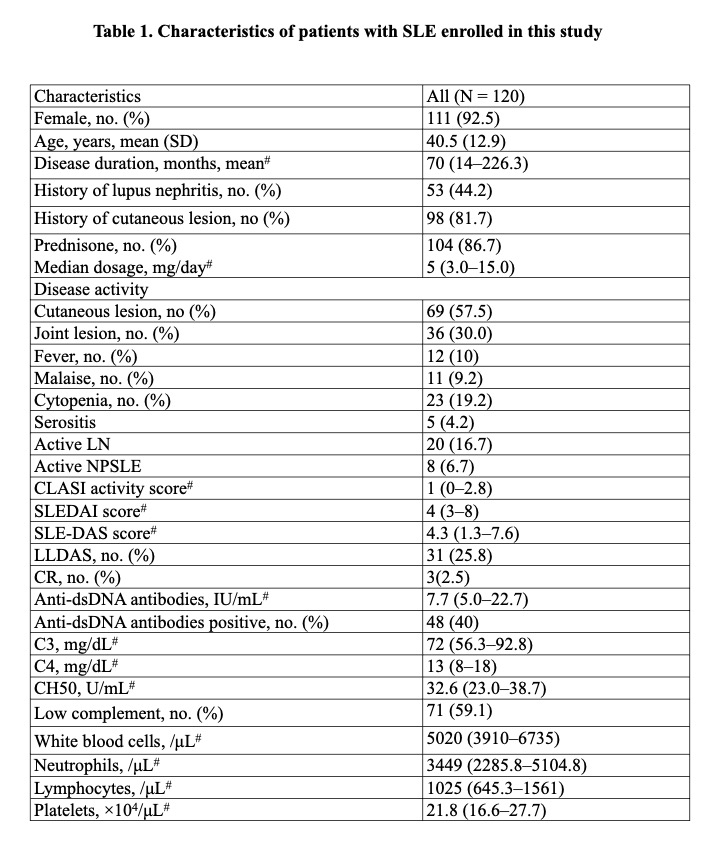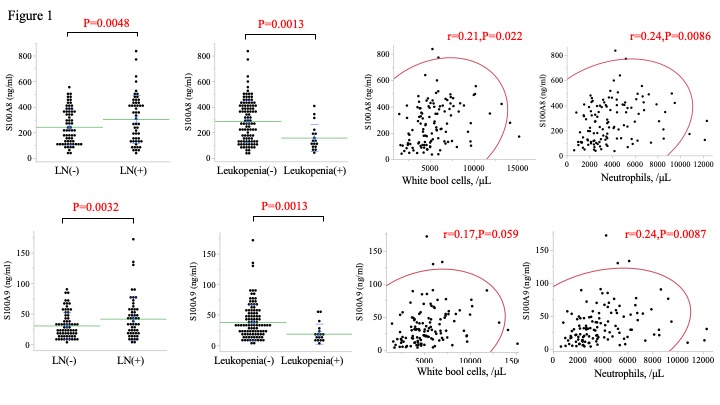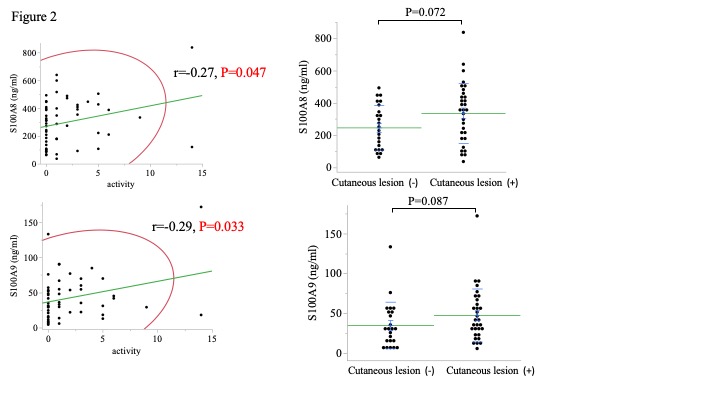Session Information
Date: Sunday, November 12, 2023
Title: (0543–0581) SLE – Diagnosis, Manifestations, & Outcomes Poster I
Session Type: Poster Session A
Session Time: 9:00AM-11:00AM
Background/Purpose: S100, a damage-related molecular pattern factor, was reported to be a biomarker associated with disease activity in SLE. Additional hydroxychloroquine, which could regulate IFN signature, was found to modulate serum S100 in patients with SLE. However, what SLE pathophysiology S100 reflects remains unclear. The study aimed to determine the usefulness of S100 as a biomarker of SLE pathogenesis.
Methods: This single-center, retrospective, observational study enrolled patients with SLE admitted to our hospital between January 2016 and December 2021. The SELENA-SLEDAI, SLE-DAS, and lupus low disease activity state scale were used to measure disease activity. Serum cytokines reported to associated with SLE activity (TNF-α, IL-8, monocyte chemoattractant protein-1, IL-1ra) were measured by multiplex Luminex assay, and serum S100A8 and S100A9 by ELISA. The correlation between these biomarkers and organ involvements was analyzed.
Results: Overall, 120 patients (9 men and 111 women; mean age, 40.5 years) were included. Table 1 shows the patient’s characteristics when measuring serum S100A8, S100A9, and cytokines. The level of TNF-α, IL-8, monocyte chemoattractant protein-1, and IL-1ra were not associated with type of organ involvements. Renal involvement was related to the level of S100 A8 and A9 (Figure 1). S100A8 and A9 levels correlated with leukocyte and neutrophil counts positively and were significantly lower in patients with leukopenia (Figure 1). The SLEDAI score showed a slightly negative correlation with S100A8 levels, but not with S100A9 levels, whereas S100A9 levels showed a slightly positive correlation with the CLASI activity score (r = 0.19, P = 0.039). S100A8 levels positively correlated with IL-1ra levels (r = 0.19, P = 0.039) and S100A9 with IL-8 and IL-1ra levels (IL-8; r = 0.30, P = 0.022 and r = 0.53, P < 0.0001). Regarding SLEDAI scores of 1–4 (n = 54), patients with higher S100A8 and S100A9 levels tended to have higher SLE-DAS scores. S100A8 and S100A9 levels were higher in patients with cutaneous lesions, which correlated with the CLASI activity score (S100A8, r = 0.27, P = 0.047; S100A9, r = 0.29, P = 0.033; Figure 2).
Conclusion: Serum TNF-α, IL-8, monocyte chemoattractant protein-1, and IL-1ra were not associated with organ lesions. However, S100 was significantly associated with renal and skin lesions, which are strongly suggested to be associated with IFN.
#Nonparametric distributions are represented as median (interquartile range [IQR]).
P-values were determined using the Mann–Whitney U test or Pearson’s correlation coefficient (r).
For statistical analysis, the Mann–Whitney U test was used for the presence of lesions, and Pearson’s correlation coefficient (r) was used for the association with CLASI activity.
To cite this abstract in AMA style:
Wakiya R, Shimada H, Nakashima S, Miyagi T, Ushio Y, Sugihara K, Mizusaki M, Mino R, Chujo K, Kagawa R, Yamaguchi H, Kameda T, Dobashi H. Serum S100A8 and S100A9 Are Useful Biomarker Indicated IFN Associated Organ Involvements in Systemic Lupus Erythematosus [abstract]. Arthritis Rheumatol. 2023; 75 (suppl 9). https://acrabstracts.org/abstract/serum-s100a8-and-s100a9-are-useful-biomarker-indicated-ifn-associated-organ-involvements-in-systemic-lupus-erythematosus/. Accessed .« Back to ACR Convergence 2023
ACR Meeting Abstracts - https://acrabstracts.org/abstract/serum-s100a8-and-s100a9-are-useful-biomarker-indicated-ifn-associated-organ-involvements-in-systemic-lupus-erythematosus/



